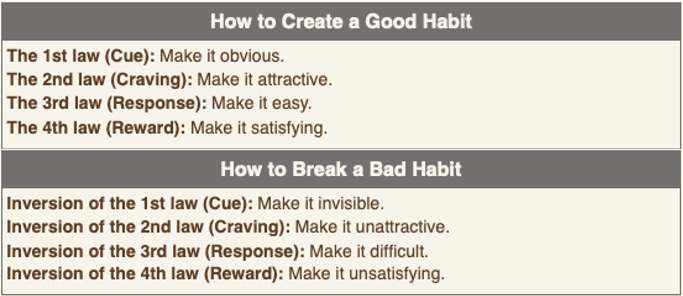Penguin Random House, 2018
Published less than 6 years ago, James Clear’s Atomic Habits has already reached iconic status, and for good reason. The clever title suggests that by starting with fundamental building blocks one can build habits and systems which have great energy and power.
“If you make small, easy changes and layer them on top of one another like units in a larger system, you can get powerful results.” - James Clear
It was hearing someone describe how the author explains his “1% Rule” from Chapter 1 that inspired me to first purchase the book. To paraphrase: an airplane is on course to travel from Los Angeles to New York. If right before take off the nose of the plane is pushed just a few feet to the left or right, the plane will land in a city hundreds of miles away from its original target. Likewise, when we adjust our behaviors just “1%” on a consistent basis, the effects multiply as we repeat them. It’s like compound interest in a money market account.
The book itself is well organized and filled with graphs and charts and other visuals which assist in absorbing the material. I especially like the bulleted summaries at the end of each chapter, the detailed table of contents, and the exhaustive, chapter-by-chapter reference section. Need more? Check out the accompanying website articles here.
Why You Want To Read This
Let’s start with a list of reasons to read Atomic Habits by the author himself:
Build a system for getting 1% better every day.
Break your bad habits and stick to good ones.
Avoid common mistakes most people make when changing habits.
Overcome lack of motivation and willpower.
Develop a stronger identity and belief in yourself.
Make time for new habits (even when life gets crazy).
Design your environment to make success easier.
Make tiny, easy changes that deliver big results.
Get back on track when you get off course.
And most importantly, how to put these ideas into practice in real life.
One might summarize further by saying, “Work smarter, not harder, and keep at it”.
Key Points and Principles:
Clear explains that all behavior is driven by the desire to solve a problem. A habit is simply behavior that has been repeated so many times it becomes automatic. We do this to avoid friction, to expend less energy, to make things easier. Habits are a mental shortcut.
“Habits reduce cognitive load and free up mental capacity so you can allocate your attention to other tasks.” - James Clear
Cue, Craving, Response, Reward: The Habit Loop
Habits are a four step process that happen continually in a feedback loop.
In step 1, our brains scan for cues, which trigger the initiation of a behavior, and predicts a reward.
Step 2 is the craving, or our reason to act (aka motivation, or desire).
Step 3 is the response, or the actual habit that is performed; the action.
Step 4 is the reward which satisfies us and teaches us.
These four steps are divided into two phases: the Problem Phase (Cue and Craving) - the realization that something needs to change, and the Solution Phase (Response and Reward) - where action is taken to achieve the desired change.
The Four Laws of Behavior Change
Understanding the Habit Loop is foundational for changing behaviors. But linking the Habit Loop to the Four Laws is when the magic happens. Not only can we build good habits, we can break bad habits by inverting the Four Laws:
While the Habit Loop and the accompanying Four Laws form the basis for the author’s system of creating the behaviors we all want to enhance our lives, there is so much more to this book. For instance, Habit Stacking, Temptation Bundling, Accountability Partner, The Two-minute Rule, and The Cardinal Rule of Behavior Change are all effective strategies on their own. But when combined with one another and the information above, the results are staggering.
Here are just two more ideas I’ll introduce here:
Identity
When we align our habits with our self-image, we are more likely to repeat the desired behaviors. As an illustration, look at these two statements:
“I sing songs.”
“I am a singer.”
If I say, “I sing songs”, I don’t convey much commitment or prioritization of my actions to myself or others. But when I say, “I am a singer.” I indicate (to both myself and others) that I repeatedly do what singers do; practice, study technique, learn new music, analyze text, seek performance opportunities, etc.
Other examples:
I read books/I am a reader.
I have kids/I am a parent.
I keep things tidy/I am organized.
Do you see the power in this subtle linguistic shift? Another important aspect of identity is that belonging to a like-minded group, is exceptionally motivating and deepens our sense of who we are. This is tribalism at its best.
Environment
Designing our environment to encourage desired behaviors is another powerful technique. When I keep my practice space set up with everything I need, I will practice more often. I have eliminated time spent preparing the space and the mental load of deciding and gathering what I need. I can just get to it. I might even take further steps to make my environment attractive, or perhaps enjoy a cup of tea as part of my practice ritual.
One More Thing…
Deeply embedded in our culture is the idea that bad habits and the resulting lifestyles are a moral failing. However, behavioral scientists who analyze individuals with tremendous self-discipline discover that they aren’t so different from those that struggle. What the disciplined people are better at is “structuring their lives in a way that does not require heroic willpower and self-control.” (p. 93)
Atomic Habits is well worth reading, and reviewing frequently. Author James Clear provides well-researched guidance on habit formation as part of an overall system of positive behavior change. He also reminds us that improvements may not be immediately visible, but consistent effort over time unlocks one's true potential. This idea encourages persistence and patience.
LISTEN: (2:54) It's a Simple Little System
Voice Lessons with Barbara
Well Coachings with Barbara
May you live in ease and kindness, with a free heart.










